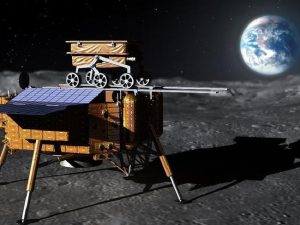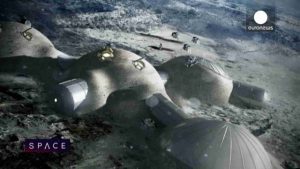 As part of the partnership between SpaceWatch.Global and the European Space Policy Institute, we have been granted permission to publish selected articles and briefs. This is ESPI Briefs No. 28: ‘China is One Step Closer to the Moon… and Europe?’, originally published in January 2019.
As part of the partnership between SpaceWatch.Global and the European Space Policy Institute, we have been granted permission to publish selected articles and briefs. This is ESPI Briefs No. 28: ‘China is One Step Closer to the Moon… and Europe?’, originally published in January 2019.
1. Chang’e-4: A New Step Towards a Taikonaut’s Moon Landing

The year 2019 started with a new landmark achievement for China’s space programme: the Chang’e-4 mission “lifted the mysterious veil” by accomplishing mankind’s first soft landing on the far side of the Moon. The spacecraft, launched on 7 December 2018, landed on the south pole’s Aitken basin, the deepest and oldest crater of the Moon, on 3 January 2019. Following the successful touchdown, the 140-kg Yutu rover was released from the lander. Both systems are now performing a series of scientific tasks, including measurements of the Moon chemical structure, astronomical observations as well as biological experiments to grow plants in the lunar environment for the first time.
The successful execution of the mission was hailed as a formidable feat for China from a geopolitical standpoint. This feat did not come as a surprise for the space community and marks a steady progress of Beijing’s plans for lunar exploration. Chang’e-4 is actually part of an ambitious decades-long programme whose roots date back to the late 1980s. The programme, as officially approved by the Chinese Communist Party in 2003, is based on an incremental approach that aims to successively fulfil three major objectives: 1) orbiting around the Moon (Chang’e-1 in 2007 and Chang’e-2 in 2010); 2) landing and roving on the Moon (Chang’e-3 in 2013 and now Chang’e-4) and 3) returning lunar samples back to Earth. This last objective will be achieved with Chang’e-5 and 6 sample return missions, which are scheduled for launch as early as 2019 and 2020 respectively.
This will mark the completion of the third stage of China’s Lunar Exploration Programme (CLEP) and pave the way to more daunting exploration missions, including, most notably, a taikonaut’s Moon landing. Indeed, thanks to the concomitant advancement of the Shenzhou/Tiangong human spaceflight programme, it is expected that China will have mastered all the building blocks required to enable such mission by the early 2020s. The mission will however probably not be part of the next (2021-2025) Five-Year-Plan – which will likely focus on the assembly and exploitation of the China’s Space Station – and should be put off to the 2026-2030 Five Year Plan. This likely stems from a technical and political cautiousness as well as from a willingness to consider more demanding plans to go beyond U.S. achievements with the Apollo programme. The alleged prospect of constructing an outpost near the lunar south pole to enable extended stays for Chinese taikonauts as well as the landing of a real Chang’e (i.e. a female astronaut) would substantiate the differentiation with the U.S. and add to China’s international prestige and leadership.
2. The Outlook for Space Diplomacy: Cooperation or Competition
Irrespective of their specific configuration and implementation timeframes, Chinese lunar plans, together with the position of the United States on a renewed American leadership in space, raise a number of questions for the international space community and, more importantly, open the way for a new era of space exploration structured around a mix of cooperation and competition.
While China has often reiterated its interest in cooperation, it has also proved very eager to translate the techno-nationalist benefits stemming from its robotic and human space programmes into geopolitical influence. Because of this, none of the major space players has, so far, engaged in an extensive cooperation with China. Quite to the contrary, suspicions on all sides have also been stimulating the emergence of competitive dynamics, particularly in the United States.
It appears in fact clear that, due to its triumphant history and current position in space, the US is extremely sensitive to any potential challenger that could alter the status quo. Any mere achievement or expansion of Beijing’s space efforts induces the United States to react, fuelling a self-propelling mechanism toward a new competition for leadership in space.
The unfolding geopolitical dynamics seem to have already set the stage for a strategic confrontation between Beijing´s rising power and Washington´s declining hegemony, and to have extended terrestrial rivalries to the space arena. Although actively discussed, the road of U.S.-China cooperation is still blocked by the Chinese exclusion policy of NASA and the current geopolitical context does not seem to offer promises of change. Actually, the road of an open competition is supported by many advocates who see rising Chinese ambitions as a demonstration of a fading American leadership in space calling for a reaction that translates into boosting NASA’s budget and initiating a new ambitious programme as illustrated by the adoption of the U.S. Space Policy Directive 1.
A new space race may eventually prove beneficial for NASA and the implementation of the Lunar Orbital Platform-Gateway (LOP-G) venture but would imply a deep change in the international landscape. In such scenario, the capacity for other countries to cooperate with both the United States and China seems unlikely. Other, less ambitious, space actors – including Europe – would therefore be forced to reconsider their approach to international cooperation.
3. European Interests … And Possibilities

On its side, Europe is already engaged, through ESA and some national space agencies, in technical discussions with NASA on its possible contributions to the LOP-G. At the same time, it has been trying to open up avenues for closer cooperation with China in human spaceflight, as demonstrated by the agreements concluded by ESA and other national space agencies regarding cooperation on the Chinese Space Station. The driver behind such posture is the recognition that the privileged way for Europe to retain a key role in the future space exploration context is to position itself as a key, although minor, player as Spanish Minister Pedro Duque recently put it at the Brussels Space Policy Conference on 22 January 2019.
This recognition has been well exemplified by ESA Director General’s vision for a Moon Village and his latest suggestion to make the Agency a “broker” and architect for a broader multilateral endeavour. Such path would secure Europe’s active involvement without facing the dilemma of choosing between mutually exclusive partnership configurations or being limited to provide minor contributions to different partner’s endeavour. However, this vision would require at least a strong political thrust from the Member States, which have so far expressed rather lukewarm reception to previous proposals of the Director General of the Agency in these matters. The effects of the current absence of position of Member States in the definition of Europe’s long-term overall ambitions shall not be overlooked, for they will not only preclude any possibility for Europe to shape the timing and priorities of the future space exploration agenda, but also condemn the continent to become a follower, most likely of US plans. It appears in fact clear that if the prospect of “two separate highways” to the Moon will eventually freeze, Europe might have no other option than to bandwagon with U.S. plans, leaving up eventual cooperation with China to national initiatives. Equally worrisome is the risk that current inaction undermines Europe’s coordinated approach to space exploration, favouring more limited national initiatives as opposed to broader communitarian efforts vis-à-vis possible partners.
In order to avoid such prospects, Europe should urgently firm up a common strategy for the post-ISS space exploration context. Time is of essence here, and the planned 2019 ESA Council at ministerial level in Spain is a key opportunity to come up with concrete answers on the role that Europe wants to play in the future space exploration. Obviously, without beforehand achieving a solid and enduring commitment at the highest political level, any decision on these matters is doomed to remain either fragile or ineffective.
Rights reserved – this publication is reproduced with permission from ESPI. “Source: ESPI “ESPI Briefs” No. 28, January 2019. All rights reserved”
For more articles please visit ESPI website (www.espi.or.at).





